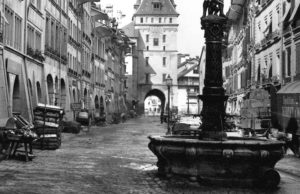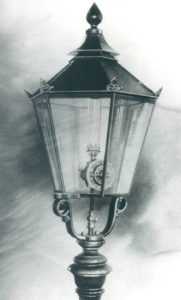
The time the Bernese put their foot on the gas
The people of Bern are known for their warmth, not for their speed. As far as gas usage goes, though, they were once well ahead of the field: in the mid-19th century, they set new standards for the whole of Switzerland.
The opening chapter of the history of gas in Bern begins with the street lighting of the city itself. Providing public lighting for roads and streets only became an issue in the mid-18th century. First of all, this was done on a voluntary basis using oil lamps. Even though more and more cities in other countries had converted to the brighter and more reliable gas lighting, the people of Bern, like the rest of Switzerland, initially stuck with the dim street lighting from oil lamps mainly due to the high costs required to switch to gas and run the new technology. The Bern police, however, were vociferous supporters of gas lighting and tried to get the city council to drop its reservations. Eventually, in 1841 a compromise was reached. A private company signed a contract with the city authorities that gave it the right to provide street lighting in Bern for 20 years.
In the very same year, the construction of a gasworks began in the district of Marzili. This produced gas from locally sourced coal and, after the railway reached the Swiss capital in the 1860s, from imported coal as well. The associated pipework had to be laid at the same time, which upset many Bernese and triggered a flood of complaints. The main objection was that traffic would be disrupted, despite the fact that the company’s engineers had to comply with strict conditions: within the space of five days, the trenches had to be dug, the pipework laid and the site covered over again. In spite of all the resistance, the lights went on for the first time on 25 April 1843. Two days later, the local newspaper Intelligenzblatt für die Stadt Bern wrote euphorically: «The lamps in the archways of Kramgasse and Marktgasse were lit for the first time, and the brightness of their light provided the clearest possible demonstration to the inquisitive crowds surging back and forth of the advantages that this new type of lighting has over the dim oil lamps burning alongside them.»

The gas lamps of the 19th century were miniature works of art. Photo: Bern city archives
Suddenly you had to greet one another at night-time too
The bright lighting was also installed into private homes before long, with people signing up to pay for the lighting according to how long they used it for. For instance, someone using gas lighting from dusk until 9 o’clock at night in 1844 had to pay around 52 Swiss francs per year, equivalent to some 450 francs today. It was primarily restaurants and businesses that benefited from this trend. There was still, however, some opposition to gas lighting. People promenading under the archways of Bern’s «Lauben» suddenly found themselves having to greet one another at night-time too, which not everyone enjoyed. Until the city switched fully to electrical lamps in 1926, Bern’s streets and archways glowed with the brightness of gas lights, heralding a new era in street lighting. More Swiss cities followed in the capital’s footsteps in setting up gasworks, benefiting from the Bernese people’s experience. Just for once, the otherwise leisurely Bernese had really put their foot on the gas and powered ahead in Switzerland.

The Kramgasse in Bern, photographed in 1894. The gas lamps that illuminated the street at the time can be seen clearly in the centre of the picture. Photo: Bern city archives



